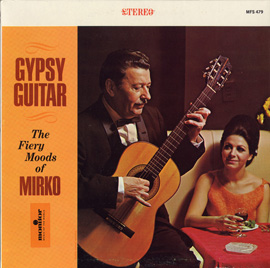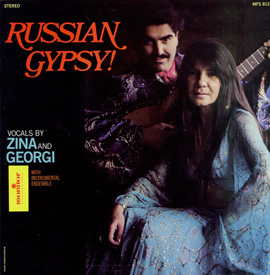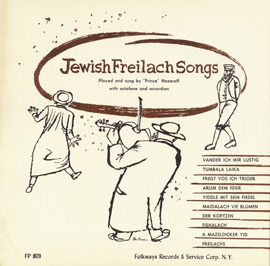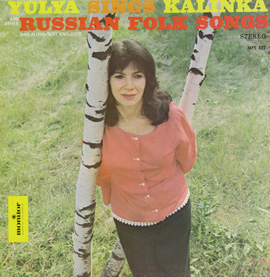Summary
This lesson uses music from Romani performers to explore basic musical concepts. Students show ternary (ABA) form in movement, sing a Russian folk song in English, practice showing phrase structure and finding and showing beat, and discriminate a rhythmic pattern at various tempi.
Suggested Grade Levels: K-2
Country: Russia, Belarus, Yugoslavia
Region: Eastern Europe
Culture Group: Romani
Genre: World
Instruments: Rhythm or Lummi Sticks (or pencils, etc.)
Language: Russian, English
Co-Curricular Areas: Drama, Dance, Social Studies
National Standards: 1, 2, 6, 7, 9
Prerequisites: None
Objectives:
- Listen to, analyze, and describe Russian Romani musical selections
- Sing a Russian folk song
- Play the beat of a musical selection on sticks
- Move to show the form of a selection
- Find a designated rhythm and show it in movement
- Evaluate vocal timbre
Material:
- “Gypsy Lullaby” and “Bright Shines the Moon” from Gypsy Guitar: the Fiery Moods of Mirko
- “In the Field Stood a Birch Tree” (“Vo Pole Beryioza Stoyala”) from Treasury of Russian Gypsy Songs
- “Poite, Tsygane” (“Sing, Gypsies”) from Gypsy Nights
- Rhythm sticks or lummi sticks
- Globe
Lesson Segments:
- The Mischievous Baby (National Standards 6, 9)
- Little Birch Tree (National Standards 1, 6, 7, 9)
- A Dance for Sticks (National Standards 2, 6, 9)
- Dancing and Listening (National Standards 6, 9)
1. The Mischievous Baby “Gypsy Lullaby” from Gypsy Guitar: The Fiery Moods of Mirko

“Gypsy Lullaby”
from Gypsy Guitar: The Fiery Moods of Mirko MON00479
- Ask the students to listen to the first melody (24 seconds) of “Gypsy Lullaby”, which is notated above.
- Ask students which instruments are making these sounds (electric guitar, bass, piano, violin)
- Ask students to pat the beat quietly while they listen a second time
- Discuss the word “lullaby”, then ask them to pantomime rocking a baby to sleep while they listen a third time
- Tell the students that the music could be a story: after the baby is put to bed, he quietly climbs out and creeps about doing mischief.
- Play the first 60” of music.
- Ask the students to listen to discover what they think the baby might be doing
- Allow the students to share their ideas
- Lead them to discover that the rocking music began again at the end of the excerpt. What happened then? (Baby was put back to bed)
- Tell the students that they are going to hear the entire story, and they should listen to find out whether or not the baby ended up in bed.
- Each time the A section melody (notated below) is heard, make gentle rocking motions
- During the B melody, have students close their eyes and imagine the baby creeping about
- When the piece ends, ask whether Baby ended up in bed, or into mischief (in bed)
- Tell the students that the man who composed the music and performed it on the guitar was one of the Romani people (the term “Gypsy” is derogatory).
- Their ancestors were from the Punjab region of northern India, and the people have spread all over Europe
- They do not have a particular homeland or country of their own
- On a globe, show the students the location of Yugoslavia, where this composer/performer is from
- Relate this to their own location on the globe
- With older students, you will want to make conscious the form of the piece. This can be done by performing the story again and drawing one cartoon or symbol for each rocking (A) section, and a different one for the mischief (B) section: A B A B A.
Extension:
The students will love acting out the story. This could occur several times, possibly over several days.
Assessment:
Are the students able to recognize when to begin rocking and when to stop? Are the students able to tell whether the baby ended up in bed or got into mischief (identify the form of the song)?
2. Little Birch Tree “Vo Pole Berioza Stoyala” (“In the Field Stood a Birch Tree”) from Treasury of Russian Gypsy Songs
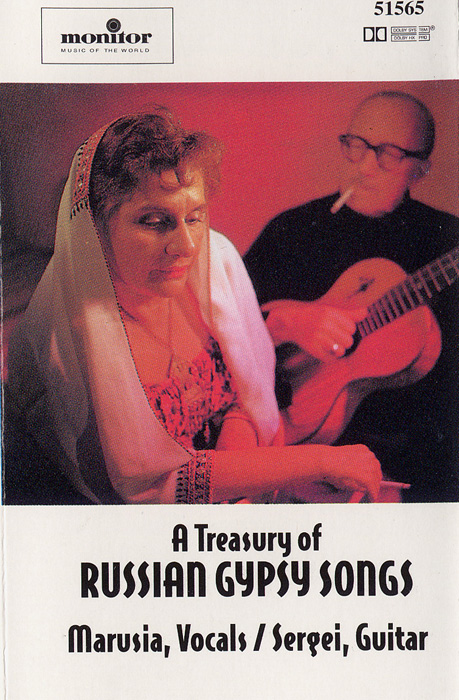
“In the Field Stood a Birch Tree (Vo Pole Beryioza Stoyala)”
from Treasury of Russian Gypsy Songs (1992) | MON71565
- A version of “Little Birch Tree” is notated above. Sing each of the four phrases (three measures each) on “Loo” for the students.
- Ask the students to show the pitch contour with their hands (how the notes go up and down: the first two go generally down; the third and fourth rise, then fall)
- Have them echo-sing the phrases, continuing to show the melodic contour, to learn the melody
- Add text and have the children perform the song, calmly and gently
- Play the recording of “In the Field Stood a Birch Tree” for the children. Ask them to raise their hand each time they hear the melody end.
- The guitar finishes playing it at 19”. Stop the recording at that point (students should have raised hands.)
- Tell the children that now they will hear a version of the song sung by a Romani woman. (See Lesson Segment 1d for information about the Romani.)
- Ask them whether they think she will sing in English. (She does not.)
- Again, they should signal the end of the melody, which is at 40”.
- The children may need help identifying this as the same melody that they sang, especially in the first half. They may need the teacher to repeat the excerpt and sing the English version while the vocalist sings in Russian.
- After stopping at 40”, resume playing the recording, asking the children to signal the end as before.
- At this point, a different melody is sung. The children should recognize that it is not the “Little Birch Tree” they sang before.
- The liner notes give the translation as: “In the field stood a birch tree. The white snow came down, The hunters came out, They caught the pretty maiden. Don’t run away, beautiful, Stay and sing a song with us! There is no one to break the birch tree.”
- Discuss the vocal quality the singer is using. Is this the same quality we used to sing “Little Birch Tree”? Have you (the students) heard anyone sing in a similar way before? Do you think this is good singing?
- Play the entire recording, asking the children to find out how many times the tune they sang occurs (three).
- Perform “Little Birch Tree” once more.
Assessment:
Are the students able to sing with appropriate affect? Are the students able to attend to the recording and recognize whether “their” melody is being sung?
3. A Dance for Sticks “Bright Shines the Moon” from Gypsy Guitar: the Fiery Moods of Mirko

“Bright Shines the Moon”
from Gypsy Guitar: The Fiery Moods of Mirko MON00479
- Tell the children they are going to hear some music composed and performed by a Romani musician (see Lesson Segment 1d for information about the Romani).
- Distribute pairs of rhythm or lummi sticks to the students.
- During distribution, you may wish to reinforce language and writing skills (and increase control of sticks) by challenging the children to see how many letters of the alphabet they can form using their sticks
- Direct the children to do what you do. Play “Bright Shines the Moon” and move your own two sticks in ways that the children can successfully copy and that conform to the music. For example, you might:
- use them to tap the beat on your knees for the first 32-beat section of the music, then form them into a “V” for 16 beats and an inverted “V” for the next 16
- point them one direction for four beats, the opposite direction for the next four, continuing for 32 beats
- alternate between touching your knees for four and your head for four, again continuing for a section of the music
- tap the beat using the right stick atop the left for 16 beats, then left on right for 16
**The more predictable you can make the patterns and changes, the more successful the children will be, and the more they will learn about how the music is organized into phrases.
Extension:
You may wish to read the children a picture book about the well-known jazz musician Django Reinhardt, who was Romani.
Assessment:
This activity is intended to allow students to practice finding the beat and feeling the phrase, so visually monitor their performance so that they are challenged some of the time and successful most of the time. That is, if they cannot perform a pattern, switch (at the end of a section) to a simpler (slower, more predictable) one.
4. A Dance and Listening “Poite, Tsygane” (“Sing, Gypsies”) from Gypsy Nights
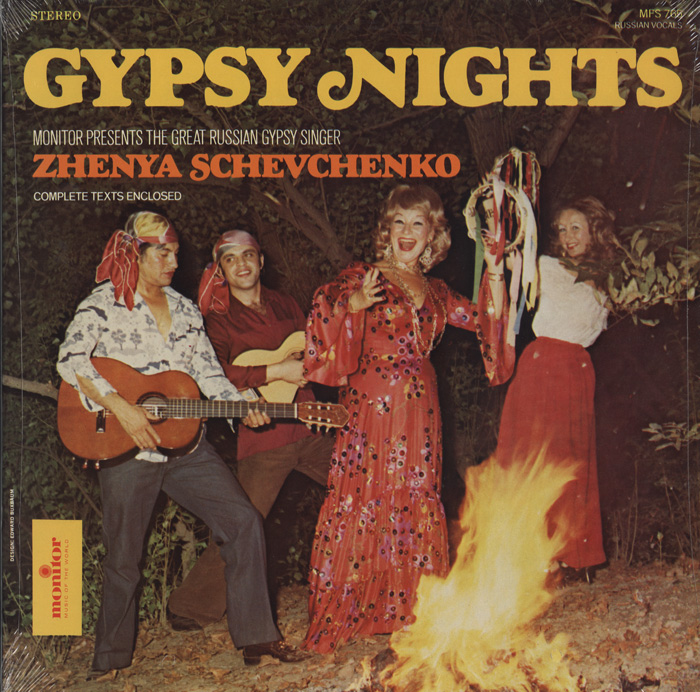
“Poite, Tsygane (Sing, Gypsies)”
from Gypsy Nights (1975) | MON00765
- Have the students echo the words, first one measure at a time, then both measures, practicing until they can say them four times in a row.
- Allow them to practice “doing what the words say” at their own individual tempi (“walk” is a step across the floor, and “pat” is a pat on the thighs).
- Have the students listen to the beginning of “Poite, Tsygane” and raise their hands when they hear the music “saying” the rhythmic pattern they practiced. When the vocalist begins to sing, stop the recording.
- Tell the children that they will pretend to be dancing around a fire in the evening, but they must respect their elders, or they will be sent to bed!
- When the woman begins to sing, they must stop romping and listen quietly and respectfully
- If the vocalist sings the rhythm they have practiced, then they may perform it; if she sings something else, they must stop dancing and listen quietly
- After listening once, let the children know that this singer (Ms. Schevchenko) is from Russia and is singing a song associated with the Romani (see Lesson Segment 1d for information about the Romani.)
- Did she sing with a steady beat? (No, Romani music often slows down suddenly and speeds up gradually)
- Repeat the track so that children can hear the song and perform the movement again.
Extension:
Many other tracks from the three albums referenced in this unit may be used as examples of similar tempo changes. Also, you may wish to read the children a picture book about the well-known jazz musician Django Reinhardt, who was Romani.
Assessment:
Do the students’ movements correspond to the music?





